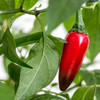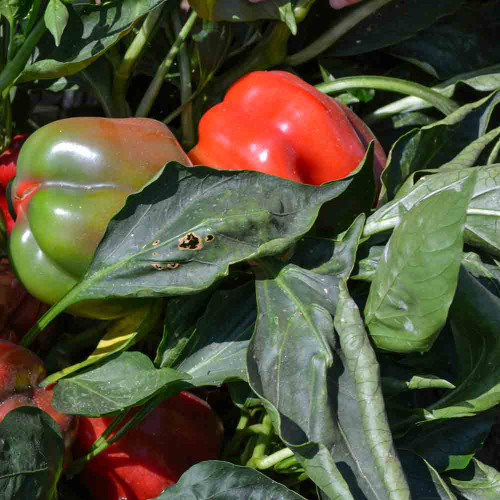Description
Nadapeño - The Sweet Jalapeño
The Nadapeño is the perfect choice for anyone wanting all of the delicious jalapeño flavors without the spiciness. Imagine your salsas, nachos, and poppers with all of that wonderful jalapeño essence but no heat! It also makes a most delightfully full-flavored pickled garlic and jalapeño without the bite. You don’t even need gloves for picking, chopping, or slicing – this is a sweet pepper posing as a spicy one!
This unique variety was developed by carefully selecting fruit with less heat but with all of the other characteristics of jalapeños over numerous generations, finally arriving at a pepper with no heat but yet loaded with flavor.
Description
Fruits are usually about 3” long and 1” in diameter, sausage-shaped with a blunt end and have shiny skin. They ripen from deep green into greenish-purple, then to a deep fire-engine red when fully mature and grow pendant, or downwards. Plants are short and robust, growing to 18 - 24” tall with lots of leaf canopy that helps shade the ripening fruit.
Blossoms will appear singly at first, then in bunches, followed by ripening fruit. A deep green c plant in full production loaded with maturing red fruit is a sight to see! In fertile soil, production is prolific, often topping 20 - 30 fruits per plant, so be prepared to share with neighbors and friends, along with lots of cooking.
History
Jalapeño is one of the most well-known spicy chiles (or peppers if you prefer) around the world and originated around the city of Xalapa in the state of Veracruz, Mexico - due East from Mexico City and almost on the Gulf of Mexico. Its name literally means “from Xalapa” and was changed to Jalapa – and thus jalapeño. The name Xalapa is itself of Nahuatl origin, formed from xālli "sand" and āpan "water place". It is thought that the ubiquitous jalapeño pepper is several thousands of years old.
Bernardino de Sahagún, a Franciscan friar, missionary priest, and pioneering ethnographer came to Mexico – known as New Spain at the time – in 1529, learned Nahuatl, the Aztec language, and spent more than 50 years in the study of Aztec beliefs, culture, and history. Sometime after 1545, he wrote in the Florentine Codex describing the long-established Aztec markets selling fresh jalapeños alongside chipotles (smoked jalapeños), and sauces made from them.
Uses
Because jalapeños are one of the most well-known and widely used chiles today, there are almost unlimited ways to use nadapeños. Salsas, either fresh or roasted, are a great starting place to enjoy the flavors. Pickled nadapeños, with or without garlic and onions, are an excellent ingredient for nachos, breakfast burritos, queso, or any dish where the sweet pickled flavors can contribute to the dish. Drying is yet another way to preserve a large harvest - dry the red ripe peppers in a food dehydrator or oven at about 150°F for several hours until they crackle when broken, then either store whole until needed or grind them into powder for the best home-made sweet chili powder you’ve tasted! If you have a smoker and can smoke-dry the peppers, you’ll have a delicious smoked paprika alternative.
Growing Tip
Small white lines often appear along the chile’s skin during ripening, sometimes described as cracks. They are actually scars from the peppers growing faster than the skin and known as “corking”. This is completely normal as the peppers heal and form the lines. Many chefs, home cooks, and gardeners consider this a desirable characteristic that shows the pepper was grown in good conditions and has great flavor.
Corking does not mean the chile is spicier!
Learn More
- Growing Peppers 101
- Chile and Pepper Growing Tips
- Grow Better Peppers with Shade
- Fermented Pepper Sauce
- Fermented Chile Paste
From the soil to the seed to the food you eat - we'll help you grow your best garden!

















